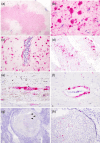Emergence of highly pathogenic avian influenza viruses H5N1 and H5N5 in white-tailed eagles, 2021-2023
- PMID: 39485726
- PMCID: PMC11529892
- DOI: 10.1099/jgv.0.002035
Emergence of highly pathogenic avian influenza viruses H5N1 and H5N5 in white-tailed eagles, 2021-2023
Abstract
Highly pathogenic avian influenza (HPAI) poses a substantial threat to several raptors. Between 2021 and 2023, HPAI viruses (HPAIVs) of the Goose/Guangdong lineage H5 clade 2.3.4.4b became widespread in wild birds in Norway, and H5N1 and H5N5 viruses were detected in 31 white-tailed eagles (Haliaeetus albicilla, WTEs). Post-mortem examinations of four WTEs revealed no macroscopic pathological findings. Microscopic examinations showed the presence of myocardial and splenic necroses and a few lesions in the brain. In situ hybridization revealed the presence of the virus in several organs, suggesting a multisystemic infection. The detection of HPAIV H5N5 in a WTE in February 2022 marked the first recorded occurrence of this subtype in Norway. Since then, the virus has persisted, sporadically being detected in WTEs and other wild bird species. Phylogenetic analyses reveal that at least two distinct incursions of HPAIV H5N1 Eurasian (EA) genotype C affected WTEs, likely introduced by migratory birds from Eurasia and seabirds entering from Western and Central Europe. Some WTE isolates from 2021 to 2022 clustered with those from Canada and Ireland, aligning with the transatlantic spread of H5N1. Others were related to the 2021 mass mortality of great skuas in the UK or outbreaks in seabird populations, including gannets, gulls and terns, during 2022 in the North Sea region. This suggests that the WTEs were likely preying on the affected birds. Our study highlights that WTEs can act as sentinels for some HPAIV strains, but the absence of several known circulating genotypes in WTEs suggests varying pathogenic effects on this species.
Keywords: H5N1; H5N5; HPAI; Haliaeetus albicilla; histopathology; surveillance.
Conflict of interest statement
The authors declare that there are no conflicts of interest.
Figures





References
-
- Bøe C, Fiskebeck EMLZ, Reiten MR, Åkerstedt J, Saghafian M, et al. Emergence of Highly Pathogenic Avian Influenza Viruses H5N1 and H5N5 in White-Tailed Eagles, 2021-2023. 2024 doi: 10.6084/m9.figshare.27089602. - DOI
MeSH terms
LinkOut - more resources
Full Text Sources
Medical

